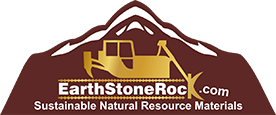Sustainability Best Practices
The materials that EarthStoneRock.com makes available to public agencies, contractors, retail outlets and consumers are produced regionally and on average transported up to 8 hours away from the quarry locations, most of which are in Arizona and Nevada. Our primary market is California which as a result of its environmental laws and regulations has pushed the decorative landscape gravel and rock industry to operate almost exclusively from Nevada and Arizona. The leadership in these states have recognized the need to have responsible rock mining operations to supply materials to landscaping market as means of dealing with long term water management problems.
We work with local or regional suppliers to fill the needs of buyers. It just happens that as result of the California's extreme environmental laws and regulations that most of the materials used as decorative rock and gravel come from Arizona and Nevada. The same materials exist in California but the ability to get effective cooperation from state officials in mining these materials largely does not exist. So in the trade off for aggressive protection of natural habitats the by product is millions of miles of heavy truck traffic coming into California with "dirt" from out of state. We wish there was another way and we continue to pursue regional quarry options for decorative rock materials but those are very limited.
Our E-commerce ordering and delivery system is unique to the outdoor building materials industry. Our platform allows us to service local and regional needs. Over time it is a service simplifies the trucking process which translates to fewer truck miles on the road and reduced emissions. When you make a full or nearly full truck order of decomposed granite, decorative landscape gravel, rip rap, landscape boulders, top soil, arena sand or of the many other bulk materials, we look to quarries in your region for materials that can be back-hauled for our yards or other clients. You may need a brown or rose colored gravel but within your region may be very nice quality horse arena sand or decomposed granite that is needed by a client in the return direction.
We partner with material handlers and truck brokers transporting these materials to try and make sure that there is a load going each direction. Finding "back hauls" encourages efficient transporting. That practice combined with modern engines and fuel-efficient technology and equipment and telematics to maximize the number of miles that can be driven on a gallon of fuel. We are also developing new innovative delivery systems for inner city and regional outdoor building materials.
All of this feeds into the LEED construction dynamics model. Where we have been able to verify LEED compliance for a quarry we will place the LEED logo on that material product page.
LEED, or Leadership in Energy and Environmental Design, is changing the way we think about how buildings and communities are planned, constructed, maintained and operated. Leaders around the world have made LEED the most widely used third-party verification for green buildings, with around 1.85 million square feet being certified daily.
LEED works for all buildings, from homes to corporate headquarters, at all phases of development. Projects pursuing LEED certification earn points across several areas that address sustainability issues. Based on the number of points achieved, a project then receives one of four LEED rating levels: Certified, Silver, Gold and Platinum
To learn more about LEED visit http://www.usgbc.org/leed
To learn more about LEED visit the LEED Credit Library
http://www.usgbc.org/node/2613082?return=/credits/homes/v4/material-%26amp%3B-resources
|
|
-
-
LEED, or Leadership in Energy and Environmental Design works for all buildings, from homes to corporate headquarters, at all phases of development. Projects pursuing LEED certification earn points across several areas that address sustainability issues
|
Sustainability Best Practices
|
|
|






